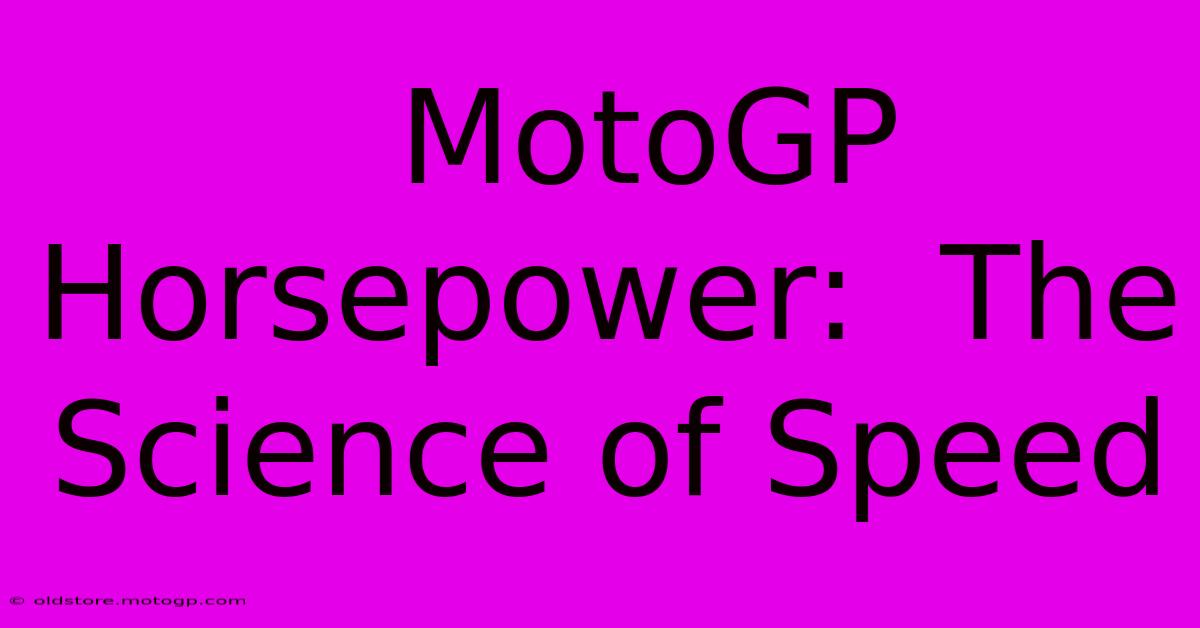MotoGP Horsepower: The Science Of Speed

Table of Contents
MotoGP Horsepower: The Science of Speed
MotoGP. The name conjures images of screaming engines, breathtaking speeds, and gravity-defying maneuvers. But what's the secret sauce behind this electrifying spectacle? A significant part of it lies in the sheer horsepower unleashed by these incredible machines. This article delves into the science behind the speed, exploring the horsepower figures, technological advancements, and the relentless pursuit of performance in MotoGP.
Unpacking the Horsepower Numbers
While precise horsepower figures for current MotoGP bikes aren't publicly released by manufacturers (it's a closely guarded secret!), estimates place them well above 260bhp. Consider this: a standard family car might produce around 150bhp. The difference is staggering, reflecting the intense engineering and technological prowess poured into these racing machines. This immense power is squeezed from relatively small engines, typically around 1000cc, showcasing the incredible efficiency and power density. The high horsepower-to-weight ratio is crucial for the rapid acceleration and high top speeds seen on the track.
Beyond the Raw Numbers: Engine Technology
The sheer horsepower isn't just about brute force; it's about sophisticated engineering. Several key technologies contribute to the incredible power output:
-
Sophisticated Engine Design: MotoGP bikes use highly advanced, inline four-cylinder engines with complex internal designs. Features like pneumatic valve actuation, seamless gearboxes, and sophisticated fuel injection systems all contribute to maximizing power and efficiency. These aren't your grandfather's engines.
-
Aerodynamics: Aerodynamics play a massive role. The sleek fairings and aerodynamic wings aren't just for show; they reduce drag and increase downforce, allowing the riders to maintain higher speeds through corners and on straights. This indirect contribution to horsepower is just as vital as the engine itself.
-
Electronics and Data Analysis: Modern MotoGP bikes are packed with electronics. Sophisticated traction control, launch control, and wheelie control systems help riders harness the massive power effectively and safely. Moreover, constant data analysis helps teams fine-tune engine settings and chassis adjustments for optimal performance. This technology provides the rider with a degree of control and safety not seen in the earlier days of the sport.
The Constant Push for More Power
The quest for higher horsepower is an ongoing arms race in MotoGP. Manufacturers constantly push the boundaries of technology to gain even the slightest advantage. This pursuit involves:
-
Material Science: Lightweight yet incredibly strong materials are crucial for reducing weight and improving power-to-weight ratios. Carbon fiber, titanium, and magnesium alloys are commonplace.
-
Fuel Technology: The fuel used in MotoGP is meticulously engineered to provide optimal combustion and power output. The fuel itself directly affects the efficiency and the output of the engines.
-
Engine Mapping and Calibration: Highly specialized software allows teams to fine-tune engine parameters for various track conditions and riding styles. This sophisticated calibration is done continuously, constantly seeking optimal engine performance.
The Rider: A Critical Component
While the horsepower is undeniably crucial, it's only part of the equation. The rider's skill and ability to manage the immense power are equally vital. The rider’s finesse in extracting the maximum power from the bike under various racing conditions, while maintaining control and safety, is a remarkable feat. The human element is fundamental to maximizing the performance of the motorcycle.
Conclusion: A Symphony of Speed
MotoGP horsepower isn't just a number; it represents the pinnacle of motorcycle engineering and technological innovation. The combination of sophisticated engine design, advanced aerodynamics, cutting-edge electronics, and the skill of the riders creates a breathtaking spectacle of speed and precision. The continuous pursuit of more power pushes the boundaries of what's possible, ensuring that MotoGP remains at the forefront of motorsport technology and thrills audiences worldwide. The science of speed is a captivating blend of engineering and human skill, pushing the limits of what's possible and constantly evolving.

Thank you for visiting our website wich cover about MotoGP Horsepower: The Science Of Speed. We hope the information provided has been useful to you. Feel free to contact us if you have any questions or need further assistance. See you next time and dont miss to bookmark.
Featured Posts
-
Yamaha V4 Engine Built For The Open Water
Feb 18, 2025
-
Moto Gp Sprint Race A Masterclass In Riding
Feb 18, 2025
-
Moto Gp Aerodynamics Separating Fact From Fiction
Feb 18, 2025
-
Moto Gp Speed The Pursuit Of Perfection
Feb 18, 2025
-
Cota Track Day Drive Your Dream Car
Feb 18, 2025
